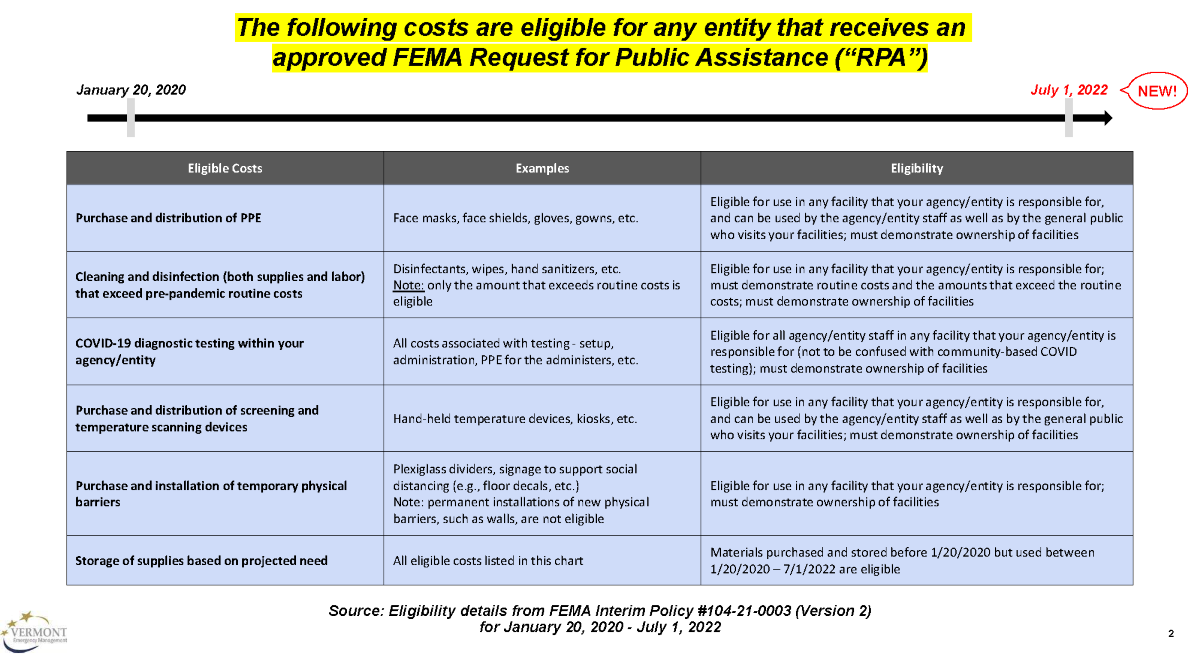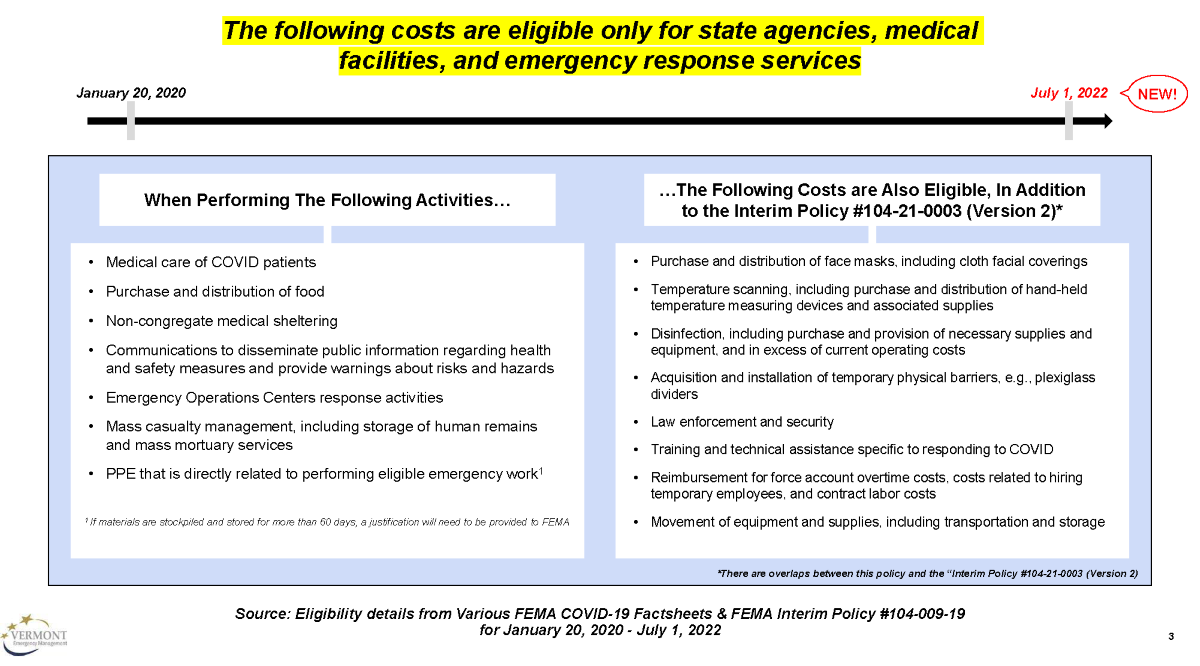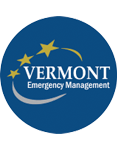Background
The President declared a National Emergency on March 13, 2020 to provide appropriate assistance for required emergency measures to save lives and to protect property and public health and safety.
The Federal Emergency Management Agency (FEMA) is authorized to provide federal reimbursement for 100% of the cost of emergency protective measures (Category B) under the Public Assistance program through the Emergency Declaration. As a result of the COVID-19 pandemic response that started January 20, 2020 and continuing, FEMA has designated all counties in Vermont as eligible for funding under Public Assistance (PA) Program, Category B – Emergency Protective Measures. Vermont’s emergency declaration is referred to as EM3437/DR4532.
Purpose
The purpose of this informational sheet is to provide local towns/municipalities, State agencies, municipal districts, and eligible non-profit organizations with financial management guidance, including a list of activities to track and document costs related to COVID-19 response. Reimbursement of these costs will be subject to eligibility determination by FEMA. To be eligible, costs must have been incurred on or after January 20, 2020. All extra costs related directly to the COVID-19 response should be tracked.
Who can apply?
EM3437/DR4532 applies to municipalities, state agencies, and non-profits if they sustained costs related to COVID-19. To be eligible, costs must fall under the definition of Category B (emergency protective measures)and applicants must be approved by FEMA through the FEMA Request for Public Assistance (see below). Guidance from FEMA is attached and summarized below.
If an eligible organization has or may have at least $3,300 in eligible uninsured Category B Emergency Protective Measure costs, the organization should submit a FEMA Request for Public Assistance (RPA) form. The online form can be found at: https://grantee.fema.gov/EventOpenRequestPeriod
FEMA requires that all applicants submit their RPAs by 7/1/2022. Applicants who do not submit an RPA before 7/1/2022 will not be able to apply for FEMA funding for the COVID disaster.
Business impact
You may be fielding inquiries from local businesses. Businesses are not eligible for FEMA Public Assistance but can apply for a small business administration loan (SBA). Information about that loan program is provided on the Vermont Agency of Commerce and Communities website at https://accd.vermont.gov. Please refer to “COVID-19 Guidance for Vermont Businesses”. Here is a link directly to the SBA website: https://disasterloan.sba.gov/ela/Information/EIDLLoans.
The U.S. Small Business Administration has approved the Economic Injury Disaster Declaration for the State of Vermont. Small businesses and private nonprofits can now apply for the low-interest working capital disaster loan online at: https://disasterloan.sba.gov/ela or by contacting the Customer Service Center at 1-800-659-2955 to request a paper application. Please see the attached Declaration and Fact sheet for advanced viewing. SBA QUESTIONS: commerce.covid19@vermont.gov.
What are the requirements for eligible applicants?
- All eligible costs must be documented.
- All procurement must comply with federal, State and local procurement requirements. Compliance with applicable procurement requirements must be documented. In cases where there are both federal procurement requirements, the more restrictive will apply. Federal procurement requires full competitive bidding for purchases greater than $250,000. FEMA procurement guidance is attached.
- Costs covered by other funding sources are not eligible for reimbursement under Public Assistance.
For example:
- Costs reimbursed by other funding programs such as Human and Health Services (HHS) funding
- Costs covered by voluntary donations
- Costs covered by insurance, Medicaid or Medicare
- Services provided under Direct Federal Assistance (DFA)
- Purchased equipment costs will be reduced by salvage value. Only costs directly attributable to the coronavirus response are reimbursable.
- Certain types of contracts are not reimbursable (e.g., time and material contracts, cost plus percentage of cost contracts, contracts with contractors on the debarred contractor list found at SAM.GOV).
- Non-competitive contracts may be used under Exigent Circumstances, but Applicants must use due diligence to ensure that the procurement is essential and that they have documented the circumstances accordingly. We do not recommend this contracting practice.
What costs to track for Category B?
Sample tracking cost sheets can be found at: https://www.fema.gov/media-library-data/20130726-1901-25045-6690/2_pa_completed_work_forms___oct_2012.pdf
Here are items that are typically required as documentation by FEMA:
- Force Account Labor
- Organization’s labor policy or agreement
- Activity log identifying employee, full-time/part-time/temporary status, title, rate of pay(hourly/salaried), days worked, number of hours worked (distinguish regular or overtime) and tasks performed. Timecards or timesheets and payroll register must be included
- Fringe benefit calculations
- Force Account Materials
- Type of supplies and quantities used, with support documentation such as daily logs
- Dates used; type of work performed
- Receipt for replacement items or local rate
- Historical cost records; Inventory records
- Receipts or invoices with Proof of Payment
- Procurement policy
- Force Account Equipment
- Description of equipment used to include year, make, and model
- Equipment size/capacity (e.g., horsepower, wattage)
- Locations, days, and hours used with equipment/usage logs
- Operator name, time used, work performed (will be cross-referenced against Force Account Labor records)
- FEMA cost codes of equipment found at: https://www.fema.gov/assistance/public/schedule-equipment-rates for the FEMA cost codes of equipment.
- Rental or lease agreements with procurement, invoices, receipts and days used and rental equipment gas costs
- Contracts and Procurement
Guidance can be found at: https://vem.vermont.gov/sites/demhs/files/pdfs/funding/public_assistance_grant_contracting_faqs.pdf
- Request for Proposal
- Copy of signed Contract and change orders with scope of work
- Procurement policies and documentation of compliance
- Bid documents
- Dates worked
- For time and materials (T&M) contracts, monitoring documentation
- Invoices, acceptance of work, and proof of payment
- Insurance
- Copy of full insurance policy
- Copies of any insurance requirements, claims made, or payments received
- Pay attention to NFIP requirements (obtain/maintain) if applicable
- Donated Resources
- Detailed log of personnel, material and equipment donated, including hours/dates and tasks performed.
What types of costs are eligible?


Emergency Operation Center (EOC) Operations Supplies, equipment, facility costs, increased utility costs.
EOC Labor/Staffing Overtime labor for regular staff. All labor eligible for temporary staff performing eligible emergency work to staff the EOC with the numbers and skills necessary to support the response, assure worker safety, and continually monitor absenteeism. Use established systems to ensure continuity of operations (COOP) and implement COOP plans as needed.
Meals for EOC employees Provision of meals, including beverages and meal supplies, for employees and volunteers engaged in eligible Emergency Work, including those at emergency operations centers, is eligible provided the individuals are not receiving per diem and one of the following circumstances apply: Meals are required based on a labor policy or written agreement, conditions constitute a level of severity that requires employees to work abnormal, extended work hours without a reasonable amount of time to provide for their own meals, or food or water is not reasonably available for employees to purchase.
Safety equipment Personal protective equipment, traffic control for drive through sites, signs for drive through sites, lighting for drive through sites.
Life sustaining commodities Food, water, ice, medicine, personal hygiene items, e.g. hand sanitizer and disinfectant for public health need. Includes protective equipment and hazardous material suits. Food and cleaning services for community members impacted by quarantine may be eligible. We encourage towns to track and document those costs, although we do not know yet whether FEMA will deem them eligible.
COVID-19 Call Center Staffing and supplies. Establishment of call centers or other communication capacity for information sharing, public information, and directing residents to available resources, updating scripts for jurisdictional call centers with specific COVID-19 messaging (alerts, warnings, and notifications).
Transportation of medical equipment and supplies Transportation of medical equipment (Oxygen equipment, Wheelchairs, Walkers, Hospital beds, Crutches, and other medical equipment) and consumable medical supplies that are ingested, injected, or applied or are for one-time use may be eligible.
Private Lab Testing Medically necessary tests and diagnosis may be eligible if not covered by insurance, Medicare, Medicaid. Applicant must verify and provide documentation on a patient-by-patient basis verifying that insurance coverage or any other source funding including private insurance, Medicaid, or Medicare, has been pursued and does not exist for the costs associated with emergency medical care and emergency medical evacuations.
Inoculation services Vaccinations for survivors and emergency workers to prevent outbreaks of infectious and communicable diseases may be eligible medical costs.
Cleaning of Facilities Applicant would have to establish legal responsibility and provide justification with a request for FEMA consideration.
Restock of consumables and medical supplies If consumables and medical supplies were used to lessen or eliminate an immediate threat required by COVID-19, this could be eligible.
Messaging/Public Outreach Providing warnings and guidance about health and safety hazards using various strategies, such as flyers, public service announcements, or newspaper.
Non-Congregate Sheltering The non-congregate sheltering must be at the direction of and documented through an official order signed by a state, local, or public health official and approved by FEMA in advance. Applicants must follow FEMA’s Procurement Under Grants Conducted Under Exigent or Emergency Circumstances guidance and include a termination for convenience clause in their contracts. The funding for non-congregate sheltering to meet the needs of the Public Health Emergency cannot be duplicated by another federal agency. Applicable Environmental and Historic Preservation laws, regulations, and executive orders apply and must be adhered to as a condition of assistance.
We recognize that the words “could” and “may” appear in several instances throughout this document. We will provide this document on the VEM website as further FEMA guidance and eligibility determinations become available.
Attachments:
Information on Federal Public Assistance Eligibility for COVID-19 (PDF)
Eligible Emergency Measures Fact Sheet for COVID-19
COVID-19 Public Assistance Simplified Application Fact Sheet
PNP Eligibility Table (Cut-out from PAPPG)
PA Application Simplification for COVID
FEMA Interim Policy #104-009-19
FEMA Interim Policy #104-21-0003
PowerPoint Presentation for Applicants Briefing
Federal Disaster Declaration 4532-DR
Federal Disaster Declaration Request
Vermont Emergency Management Public Assistance Program Site
Federal Emergency Management Agency Individual Assistance Program Site
Questions? Contact Vermont Public Assistance Officer Kim Canarecci: kim.canarecci@vermont.gov.

